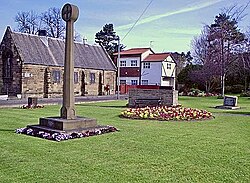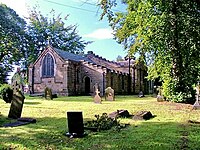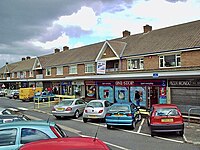Marton-in-Cleveland
| Marton-in-Cleveland | |
| Yorkshire North Riding | |
|---|---|
 Marton village green | |
| Location | |
| Grid reference: | NZ515160 |
| Location: | 54°32’14"N, 1°12’17"W |
| Data | |
| Population: | 9,990 |
| Post town: | Middlesbrough |
| Postcode: | TS7, TS8 |
| Dialling code: | 01642 |
| Local Government | |
| Council: | Middlesbrough |
| Parliamentary constituency: |
Middlesbrough South and East Cleveland |
Marton, known in full as Marton-in-Cleveland, is a village subsumed into the townscape of Middlesbrough in the North Riding of Yorkshire. Until the 1950s, it was a small village next to the hamlet of Tollesby. Development since this period has turned it inot a southern suburb of Middlesbrough.
Within the village is Stewart Park, a large public park given by a former councillor, Dormund Stewart, to the people of Middlesbrough in 1928.
James Cook
The explorer, cartographer and navigator, Captain James Cook was born to James and Grace Cook, in a clay-built cottage in the village of Marton in 1728, and he lived for a short time in the village, until the family moved to Great Ayton.[1] A contemporary drawing of the village by George Cuit has revealed the cottage to have significantly deteriorated by as early as 1788, a precursor to it being levelled by new local landowner, Bartholomew Rudd, in the 1790s.[2] It was very close to where the original manor house Marton Lodge eventually stood, to which Rudd made many alterations.
Because of Cook's great discoveries in the antipodes and the Pacfic, the name 'Marton' was given to a number of towns built in the Empire.
St Cuthbert's Church

There is no record of the foundation of St Cuthbert's Church, but there is evidence that it dates from the 12th century, in the Norman period. At that time the overlords of Marton were the de Brus family, ancestors of Robert the Bruce of Scotland.[3] They had founded Gisborough Priory in 1119, and succeeding generations of the family bestowed gifts of land and property on this and other religious houses in the area. The church at Marton was one of those gifts to Guisborough, given before 1187.
In 1540 when the priory was dissolved by King Henry VIII, all the property belonging to the priory reverted to the Crown. In 1545 the living of Marton was granted to the Diocese of York, where it remains to this day.
In 1843 and 1847 a major refurbishment took place, mainly financed by J.B. Rudd of Tollesby Hall, the local squire.[4]
James Cook was baptised at St Cuthbert's Church. The church is now ornamented with a stained-glass window commemorating Cook.
The churchyard contains graves of Henry Bolckow and John Vaughan, the founders of Bolckow Vaughan — the company which brought the steel industry to Middlesbrough.
Sport
- Cricket: Marton Cricket Club (founded c.1853)
- Junior football: Marton F.C.,

Outside links
| ("Wikimedia Commons" has material about Marton-in-Cleveland) |
References
- ↑ The Captain Cook Encyclopædia, p. 144. John Robson. Random House Australia. ISBN 0-7593-1011-4.
- ↑ Winn, Christopher (2010). I never knew that about Yorkshire. London: Ebury. p. 70. ISBN 978-0-09-193313-5.
- ↑ A History of the County of York: North Riding - Volume 2 pp 264-268: Parishes: Marton (Victoria County History)
- ↑ Evans, Peter (1995). Church Fabric in the York Diocese 1613–1899: The Records of the Archbishop's Faculty Jurisdiction : a Handlist. Front Cover Borthwick Publications. pp. 57. ISBN 9780903857598. https://books.google.com/books?id=lqMtjEZQo7AC&q=j+b+rudd+marton&pg=PA57.
